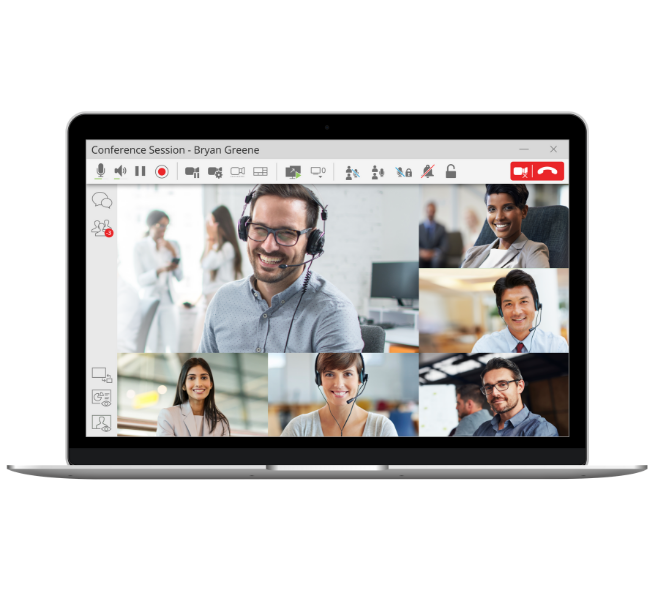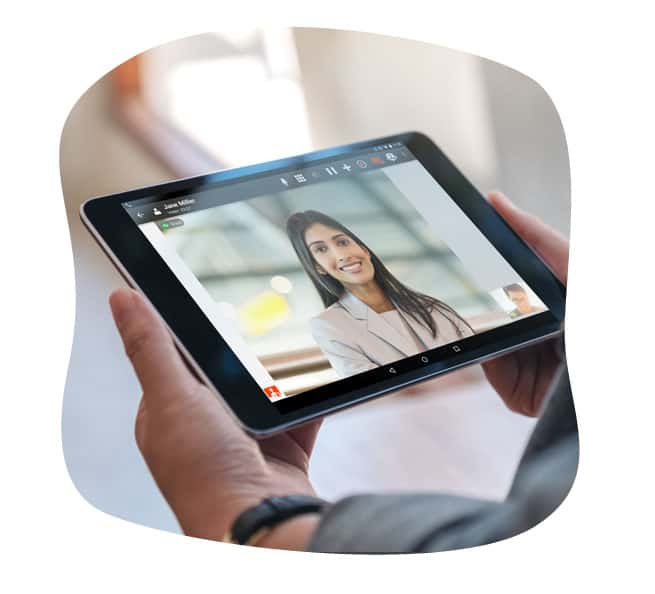Table of Contents
Videotelephony: What is & How it Helps
Videotelephony is a piece of software on your computer, or mobile device, that uses the camera and microphone to allow you to have a virtual face-to-face conversation with another person or group of people.
Also called video chat, you can connect real-time with one person or a group of people and see and hear the other person, allowing you to carry on a conversation, conduct a meeting or run a class, video conference or workshop.
There is a huge rise in videotelephony recently as more and more people are working remotely or connecting with people through video chat rather than traveling. More online chat can either reduce the expense of travel, extend your reach to connect with more people in a short amount of time, or in recent days keep safe and stay at home during the pandemic.
Video, rather than just audio, provides a significant improvement in a conversation over just Voice-Over-IP (VOIP). You can see someone’s expression and read their reaction. If someone is smiling or has anger on their face you can adapt your message quickly. In addition, if you’re in a meeting with multiple people, you can see someone about to speak or give you a thumbs up if they agree. Videotelphoy conferencing software communicates so much more than just audio.
Videotelephony platforms support video and audio
You need the tools and equipment to support both video and audio for videotelephony. You’ll need a microphone, speakers or a headset, as well as a camera. Modern cell phones provide all the equipment you’ll need to connect to a video chat, which is very handy if you’re remote. If you’re in a long meeting, both the quality and convenience of a laptop or desktop setup can be handy. Holding your phone out in front of your face for an hour is tiring. And the quality of audio, and potential background noise on a mobile phone can interfere with the clarity of conversation.
Videotelephony platform setup 101: Think about the space you’re in
If you’re a regular on video calls, you’ll want to invest in the right equipment and setup to have great conversations. Video chat exposes not just you, but your surroundings. Spend a little time thinking about and arranging your background to suit your conversation. If you’re in a professional meeting, or a job interview, you’ll want to carefully attend to what is visible behind you.
Background
The ideal background videotelephony is uncluttered, with some pleasing visual elements behind you. Virtual backgrounds are handy if you can’t clear up the environment behind you, or if you have a doorway or open space behind you that may have people passing through it.
Reduce noise in and around the space you’re in
Find a space that is quiet and has a controlled environment when possible. If you’re at a window beside a busy street, it can be disruptive to have sirens or honking interrupting your meeting. If you can close a door and isolate your sound that is ideal. Also think about the elements on your desk. Do you have a coaster under your ceramic coffee mug, are your keys put away so they’re not jangling and disruptive? Also think about what is around the microphone. If you have a fan blowing across your microphone it will disrupt the ability of the microphone to pick up your voice.
Put doors or windows in front of you
If you do have a door or window in the room, put it in front of you (or behind the screen/camera). If it’s a window, then the light from it will fall on your face and improve your lighting. If it’s a doorway, then if someone enters, they’re not immediately part of your meeting.
Lighting
The quality of your video call, or videotelephony meeting, is greatly impacted by lighting. If you can, pick a room with lots of natural light. Make sure that light is in front of you, not behind you. If you are in a space that appears dark, invest in some lighting. You can get ring lights or LED panel lights starting at $15-20 and they make a significant difference on the appearance of your video. Your expression will be easier to read and you will appear more professional. If you’ve ever video chatted with someone with a window behind them, you’ll notice you can’t read their expression or see their reactions.
Ambient noise
There is only so much you can do to control the world around you, but think about what’s on your desk and which room you choose to connect from. If you’re at home and you live on a busy street, is there a room far from the busiest street? If you’re in a noisy house, can you find a quiet spot in the basement?
What’s on your desk
Having lots of papers on your desk to rustle may not be the best strategy if you’re hoping to have a productive meeting. Think about rattling or clanging noises that might get bumped during a meeting. If your desk phone, or cell phone is on your desk, make sure it is turned to silent. A call or text during a meeting can be quite disruptive, and show you’re not paying attention.

For a great videotelephony experience, invest in equipment
If you spend hours each day on videotelephony meetings, or if your job is remote with a lot of your communication done online, spending a little money on some key pieces of equipment will make a significant difference in the quality of your online presence.
Great microphone
The device built into your Mac, iPad, iPhone or Android will do a reasonable job picking up your voice; however, if you spend a lot of time on videotelephony chats, especially if it’s hours each day you should really invest in a high quality microphone. Starting at $50 you can get an excellent microphone that will pick up more of the dynamic range of your voice, and isolate out background noise.
Great camera
A high end webcam will improve your videotelephony quality in a few key ways. It will allow you to point the camera to best frame you and your background, while keeping your screen in an optimal location. You can also get a better framing of yourself for an ideal background, either virtual or real.
Green screen
If you really want to get a great virtual background experience, invest a little money in a green screen. If you put a green screen (literally a large piece of cloth that is a bright color green) behind you it will be easiest for the software to separate you from your background to make it look like you’re sitting on the beach, or in a fancy office.
Dedicated space
Another step you can take to create an excellent videotelephony chat experience is to set up a dedicated space. If you have a microphone, camera and green screen, you’re likely well on your way to a dedicated space. Adding a few sound baffles to the walls will further increase the quality of the sound and reduce ambient noise.
Broadband Bandwidth
One essential element to high quality, low latency video and telecommunications is high speed internet. If you want to support videotelephony conferencing systems, webinars, screen sharing and voice calls you’ll need to have a fast internet connection and strong Wi-Fi.

Videotelephony etiquette
When you spend a lot of time on video chat, a few key pointers can improve your experience and keep you and your co-workers on good terms and working efficiently.
Mute when you’re not talking
If you’re in a large group, ensure you put yourself on mute when you’re not talking. If there is a noise in your background, or you cough or clear your throat the sound from your environment can impede or interrupt the person who is talking. It’s polite to keep yourself on mute until you’re ready to talk. It is also a sign to others that you have a point to add to follow up if you ‘come off mute’ a good facilitator will notice and bring you into the conversation.
Cameras on when you have them
Whenever you’re in a group conversation it’s ideal to turn on your camera. If you’re in a group and some people have their cameras on, and some are ‘lurking’ with their cameras off it can create an imbalance. It feels weird when you can read the reactions of some people, and not from others. It also makes it difficult to see when someone has a point to make or is about to speak.
Use text or chat to add discussion points or questions
You can also add points, ask questions or identify you’d like to speak in chat. If you’ve got a follow up question you can ask that in chat, and the person speaking can respond to your question when they’re done. You can ask a question, make a counter point or add in a joke without verbally interrupting. It’s a great way to use the functionality of the platform that’s a significant improvement over phone calls.
Keep a queue of speakers in chat
If you’re moderating or facilitating a meeting, you can note anyone who would like to speak next and keep a running tally in chat or a messaging window. Then each person on the list can see when it’s their turn to speak and step into the conversation in an orderly fashion without interrupting or talking at the same time as someone else.
If you need to eat, excuse yourself from video
When you have a lot of meetings in your day sometimes you need a snack or a meal. If you’re eating, ensure you’re on mute and either verbally or in chat identify that you’re eating and turn off your video while you’re eating.
Videotelephony is an incredible and powerful tool. If you’re looking for a great video conferencing solution with great pricing download Bria Teams and get started today.
Interested in the Ultimate Videotelephony Tool for your Virtual Team?
Get in touch with our team today.

